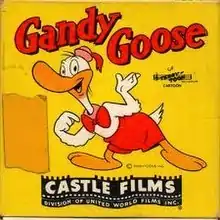Gandy Goose
Gandy Goose is a Terrytoons cartoon character who first appeared in the 1938 short Gandy the Goose.[1] He is frequently paired with Sourpuss, a cat, beginning in the 1939 short Hook Link and Sinker. Sourpuss' first appearance was in the 1939 The Owl and the Pussycat. Originally voiced by composer and orchestral arranger Arthur Kay from 1939–1941, Gandy spoke in a lyrical vocal parody of radio comedian Ed Wynn while Sourpuss vocally impersonated an impatient Jimmy Durante. Their surreal adventures often showcase extended dreams, bookended by coarse bedroom arguments.
| Gandy Goose | |
|---|---|
| Terrytoons character | |
 | |
| First appearance | Gandy the Goose (1938) |
| Created by | Paul Terry |
| Voiced by | Arthur Kay (1938–1941) Tom Morrison (1942-1955) Patrick Pinney (1987–1988) |
| In-universe information | |
| Species | Goose |
| Gender | Male |
Gandy was used to promote the U.S. war effort during World War II. In the cartoons Gandy Goose joined the US Army in 1941 in the cartoon "Flying Fever" and also in "The Home Guard."[2]
Gandy Goose appeared in a total of 49 cartoons between 1938 and 1955.[3] He also made two appearances in Mighty Mouse: The New Adventures (1987–1988) voiced by Patrick Pinney.
Gandy Goose (along with Sourpuss) is one of the only characters who didn't appear in the 1999 Terrytoons pilot Curbside. This was done to avoid comparisons to Ren and Stimpy.
Comic books
Gandy Goose and Sourpuss also appeared in comic books, beginning in 1942 and lasting until 1964. Starting out published by Timely Comics, Gandy Goose was a regular feature in such titles as Terry-Toons Comics and Mighty Mouse, as well as the superhero titles Young Allies and Captain America Comics. In 1947, St. John Publications took over the licensing of Terrytoons characters; Gandy Goose continued to appear in Terry-Toons Comics and Mighty Mouse as well as Dinky Duck, Heckle and Jeckle, and his own self-titled series, which ran four issues from Mar. 1953 to Nov. 1953. Gandy Goose appeared in issues of Dell Comics' New Terrytoons title in the early 1960s and then in Mighty Mouse when it was being published by Western Publishing.
Filmography
Gandy Goose appeared in the following 49 cartoons:[3]
- Gandy the Goose (March 4, 1938)
- Goose Flies High (Sept 9, 1938)
- Doomsday (Dec 16, 1938)
- The Frame-Up (Dec 30, 1938)
- G-Man Jitters (March 10, 1939)
- A Bully Romance (June 16, 1939)
- Barnyard Baseball (July 14, 1939)
- Hook, Line and Sinker (Sept 8, 1939)
- The Hitchhiker (Dec 1, 1939)
- It Must Be Love (Apr 5, 1940)
- The Magic Pencil (Nov 15, 1940)
- Fishing Made Easy (Feb 21, 1941)
- The Home Guard (March 7, 1941)
- The One Man Navy (Sept 5, 1941)
- Slap Happy Hunters (Oct 31, 1941)
- Flying Fever (Dec 26, 1941)
- Sham Battle Shenanigans (March 20, 1942)
- The Night (April 17, 1942)
- Lights Out (April 17, 1942)
- Tricky Business (May 1, 1942)
- The Outpost (July 10, 1942)
- Tire Trouble (July 24, 1942)
- Night Life in the Army (Oct 12, 1942)
- Camouflage (Aug 27, 1943)
- Somewhere in Egypt (Sept 17, 1943)
- Aladdin's Lamp (Oct 22, 1943)
- The Frog and the Princess (April 7, 1944)
- The Ghost Town (Sept 22, 1944)
- Gandy's Dream Girl (Dec 8, 1944)
- Post War Inventions (March 23, 1945)
- Fisherman's Luck (March 23, 1945)
- Mother Goose Nightmare (May 4, 1945)
- Aesop Fable: The Mosquito (June 29, 1945)
- Who's Who in the Jungle (Oct 19, 1945)
- The Exterminator (Nov 23, 1945)
- Fortune Hunters (Feb 8, 1946)
- It's All in the Stars (Apr 12, 1946)
- The Golden Hen (May 24, 1946)
- Peace-Time Football (July 19, 1946)
- Mexican Baseball (March 14, 1947)
- The Chipper Chipmunk (March 9, 1948)
- Dingbat Land (Feb 1, 1949)
- The Covered Pushcart (Aug 26, 1949)
- Comic Book Land (Dec 23, 1949)
- Dream Walking (June 9, 1950)
- Wide Open Spaces (Nov 1, 1950)
- Songs of Erin (Feb 25, 1951)
- Spring Fever (March 18, 1951)
- Barnyard Actor (Jan 25, 1955)
References
- Rovin, Jeff (1991). The Illustrated Encyclopedia of Cartoon Animals. Prentice Hall Press. pp. 101–102. ISBN 0-13-275561-0. Retrieved 8 April 2020.
- Michael S. Shull, David E. Wilt (April 2004). Doing Their Bit: Wartime American Animated Short Films, 1939–1945. Mcfarland & Co Inc Pub. p. 104. ISBN 978-0-7864-1555-7.
- Lenburg, Jeff (1999). The Encyclopedia of Animated Cartoons. Checkmark Books. pp. 82–84. ISBN 0-8160-3831-7. Retrieved 6 June 2020.
External links
- Gandy Goose Cartoon Filmography at The Big Cartoon Database
- Gandy Goose at Don Markstein's Toonopedia. Archived from the original on August 1, 2016.
- Gandy the Goose, 1938 cartoon (first animation where this character featured)
